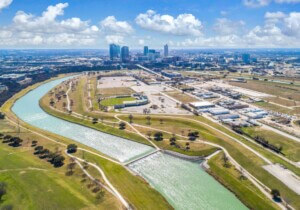Austin, Texas–based architects Dan Cheetham and Michelle Tarsney have given a new face to some of the city’s underutilized spaces: alleyways. Their one-of-a-kind community art installation, 20ft WIDE, seeks to resolve conflict between architecture, art, and humanism in order to create places of lasting value. The once forgotten alley between Ninth and Tenth streets, which connects Congress Avenue and Brazos Street in Downtown Austin, has been transformed into a collaborative space to bring attention to public urban places and foster discussion about the new possibilities for their uses
The name 20ft WIDE stems from Austin’s original 1839 master plan, which called for each of the city’s alley to measure, well, 20 feet wide. Austin’s structure consists of many open spaces and side streets that are not being used solely because they go unnoticed by nearby wanderers. Cheetham and his associates argue that these alleys are, in fact, vital components of the city that are being menaced by super-block development that will ultimately alter the grain and scale of the urban fabric.
The initial stimulus of the installation was to bring awareness about the role of these spaces and to generate communal discussions about possibilities for their use. Cheetham explained that “most alleys are overlooked as something that is just a necessity—they serve a utilitarian function, such as trash collection for instance.” For him, alleys are a valuable urban asset. They create a gap in mid-blocks, meaning that buildings do not go over them: “they break up the grain which allows for more sunlight and air to penetrate the city street. This is a reason why they feel so nice.”
In an interview, Cheetham told AN that 20ft WIDE was part of a larger collaborative project. When asked why the installation had been set up in that specific alley, he explained that the group had initially identified six or seven different urban alleys, and that in order to settle for just one “the trick was to find an alley that had an intersection of several things. It should be located in an area that is not in conflict with people or security measures. Moreover, we were looking for an alley that had some kind of historical significance or interest.” He noted, “we were on a very limited budget and were given a quick time frame. Therefore, we needed an alley that had enough quality esthetic to stand on its own with minimal interruptions.”
The project was initiated last April, when the team began installing twines of bright colors and different shades all across the alley. They also worked with an Austin-based art education organization, Creative Action. The group created “Peace Cranes”, a project which involved young individuals who folded over 1,000 pieces of origami a week prior at the city’s arts festival. The cranes were integrated in the 20ft WIDE installation as a symbol of peaceful community building. The alley is also filled with stacked pallets, burlap sacks in which people have generously given away clothing, polystyrene shipping foam as well as donated plant materials. The jovial and creative nature of the installation is meant to give rise to thought provoking conversations about the role that unused spaces and tucked-back streets play within the city center.
Dan Cheetham attended The University of Texas, and later founded Fyoog, a firm inspired by his passion and love for music, the arts, and all things pertaining to architecture, urbanism, and their sub-disciplines. Fyoog’s underlying principles are to combine architectural design and functionality into abandoned or under-utilized urban space, in order to give them a new purpose. Cheetham is deeply concerned with the public realm, and seeks to engage individuals within their city’s creative process. The group hopes the project can be made permanent in the future.










